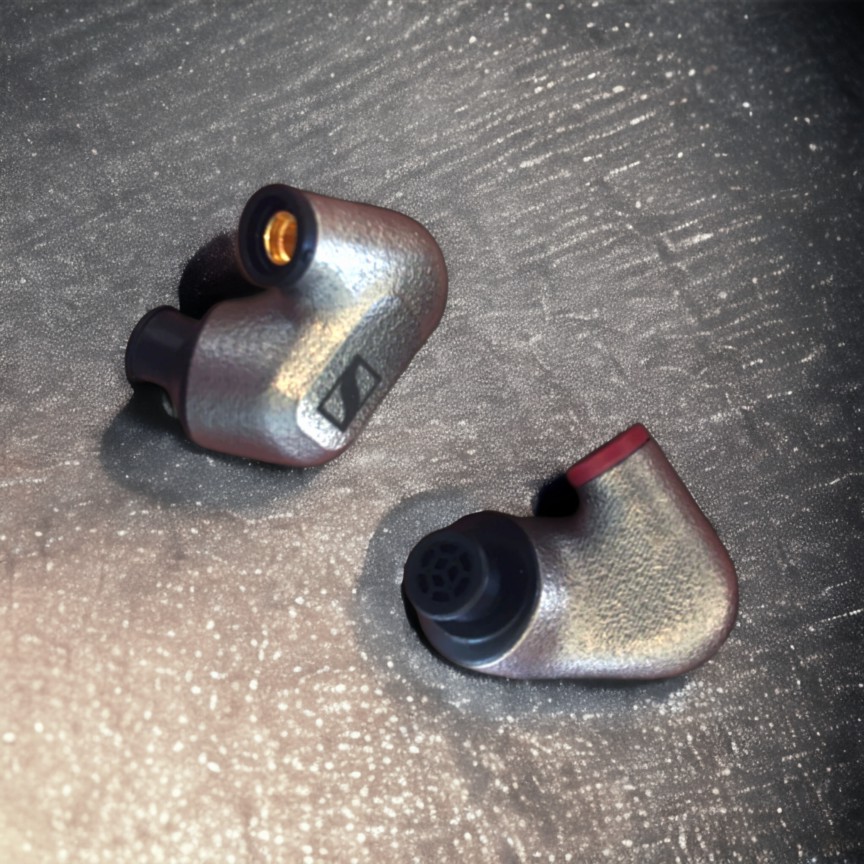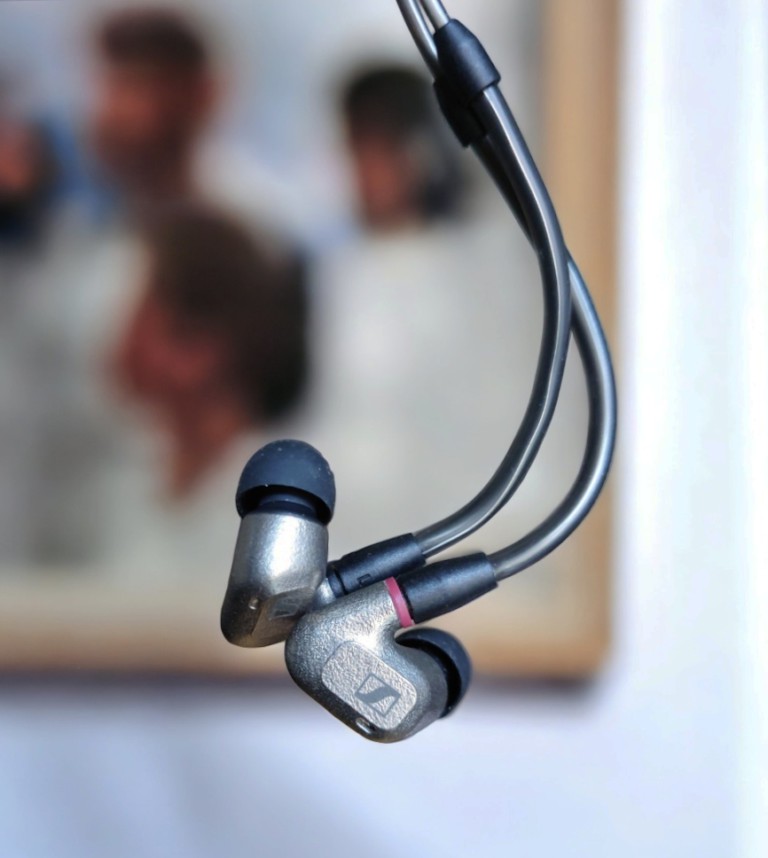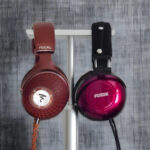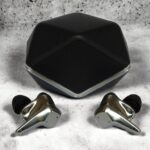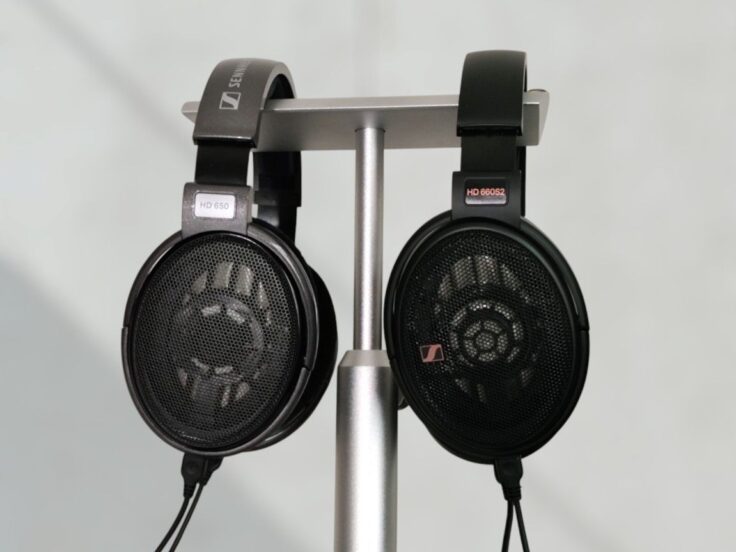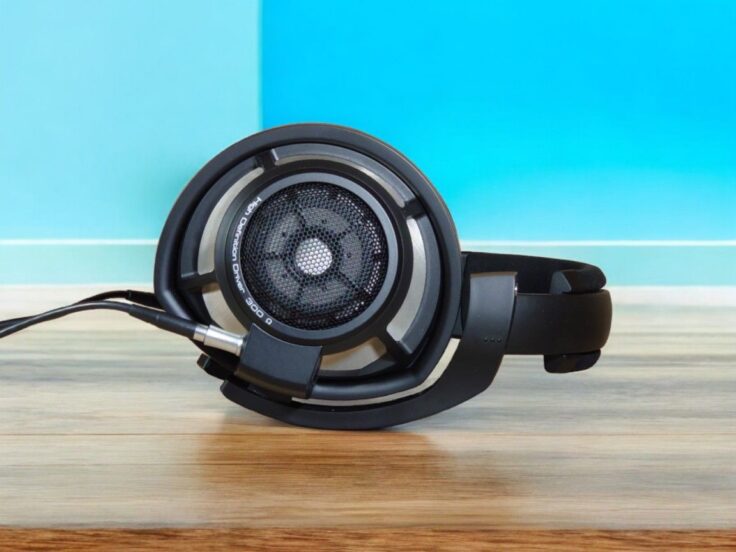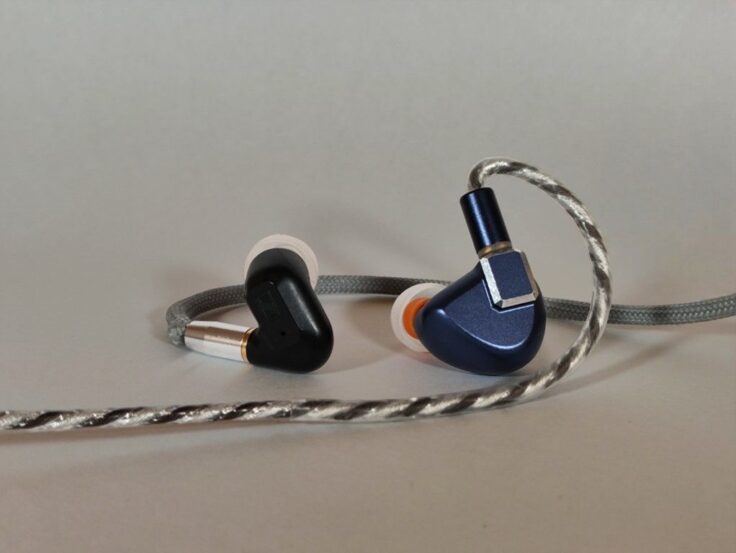The Sennheiser IE600 is a small, metal-body single driver in-ear monitor, being the step below the flagship IE900 in the current Sennheiser lineup up audiophile IEMs. It shares the same form factor as its siblings.
WHAT WE LIKE
- Fabolous sound: Lots of detail, precise imaging, strong but tight bass, delicate mids and clear highs
- Built to last
- Comfortable
WHAT WE DON’T LIKE
- Expensive
- Needs a powerful source to shine
- Flange surrounding connectors makes 3rd party cables difficult to fit
Check price: Sennheiser IE600
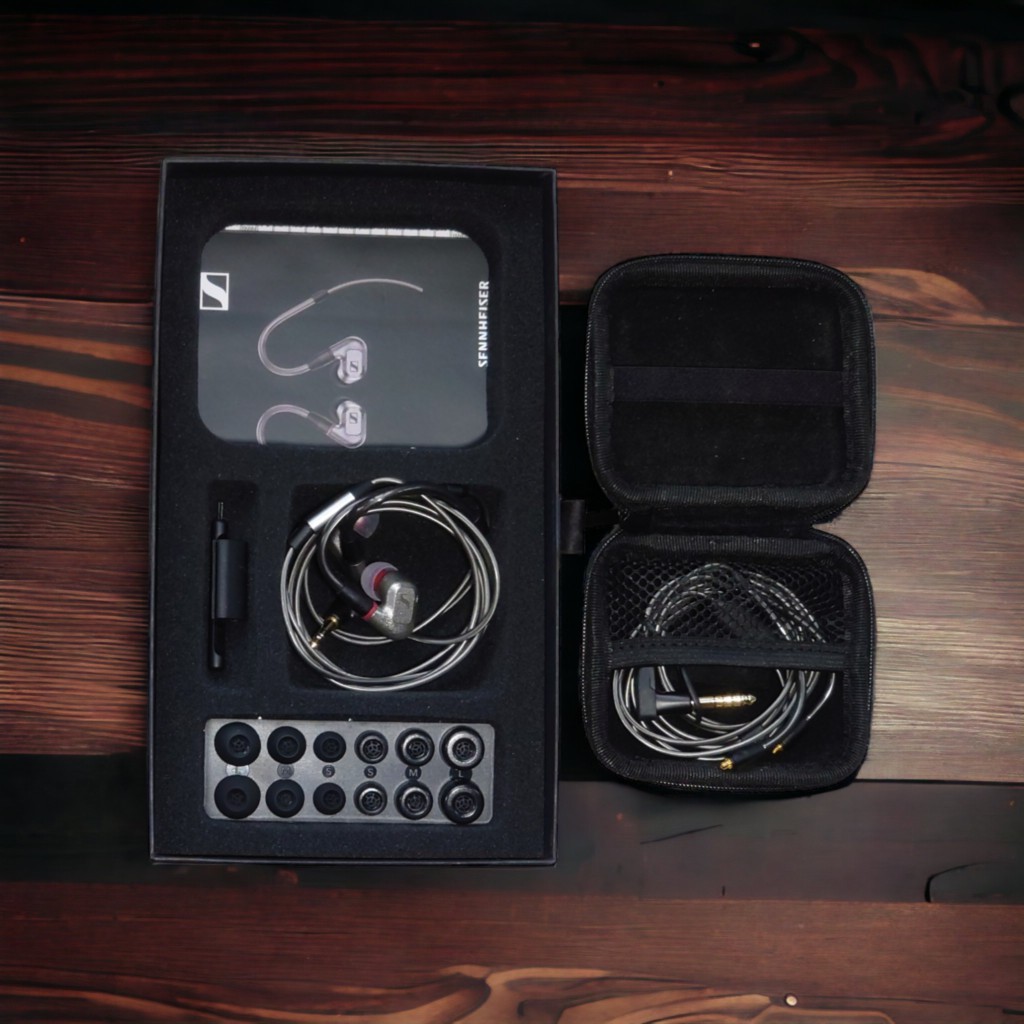
WHAT’S IN THE BOX
- A pair of IEMs
- Carry Case
- 3.5mm unbalanced connector cable 1.25 m w/ear hook
- 4.4mm balanced connector cable 1.25 m w/ear hook
- 3 pairs of silicone tips (S, M, L)
- 3 pairs of foam tips (S, M, L)
- Cleaning tool
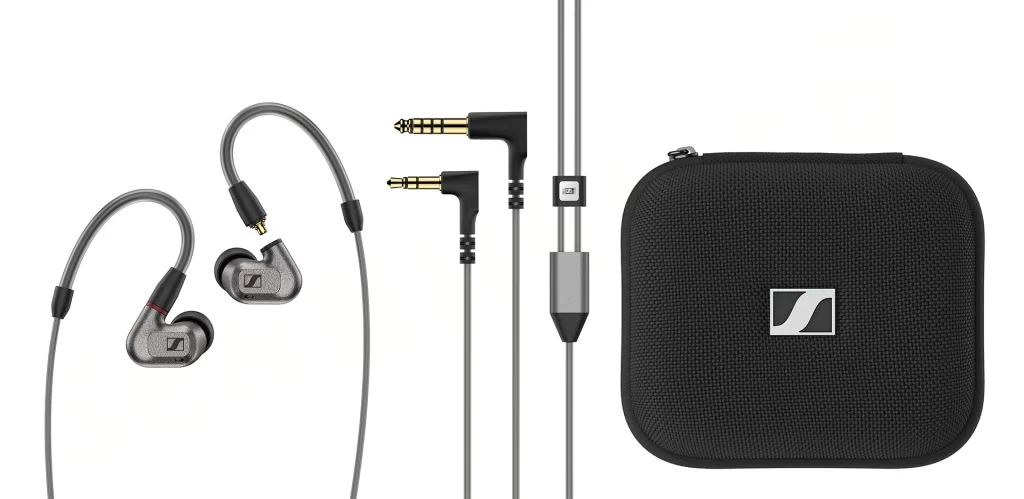
SENNHEISER IE600 SPECIFICATIONS
- Single dynamic 7mm extra-wideband True Response transducer, the same as in the IE 300, IE 300 and IE 900.
- D2CA dual resonator chamber technology
- 3D-printed AMLOY-ZR01 amorphous metal housing
- Impedance: 18 Ohm.
- Sensitivity: 118 dB (1 kHz, 1 Vrms)
- Frequency response: 4 Hz – 46.5 kHz
- THD: <0.06% (1 kHz, 94 dB)
- Weight (w/o cable): 6g each
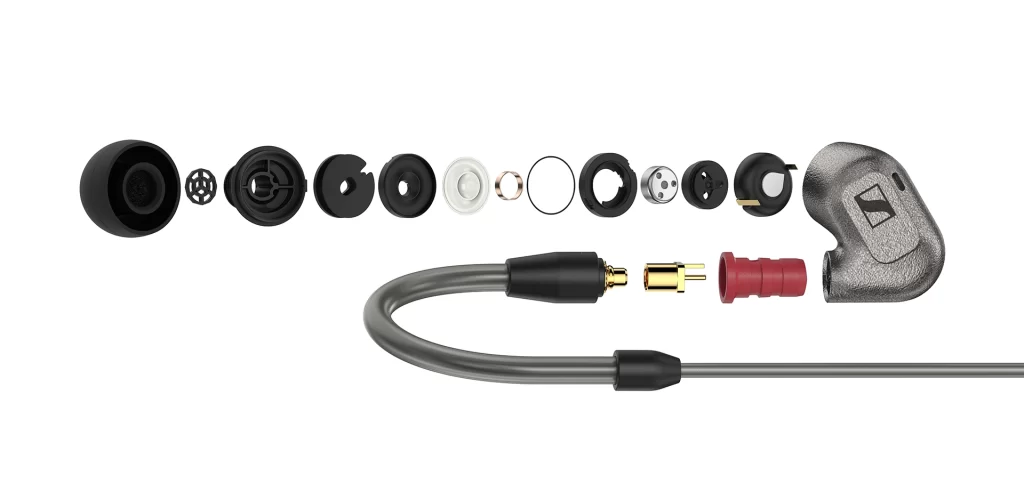
CONSTRUCTION, COMFORT AND FUNCTIONALITY
The IE600s are extremely small and light. It’s assembled by hand in Germany. The housing is 3D-printed in a special alloy metal called AMLOY-ZR01, which is stronger than steel. They look and feel very sturdy even though they are very lightweight at 6 g.
Internally they have dual resonator chambers to optimize the sound. These are small chambers that cancels out or enhances frequencies.
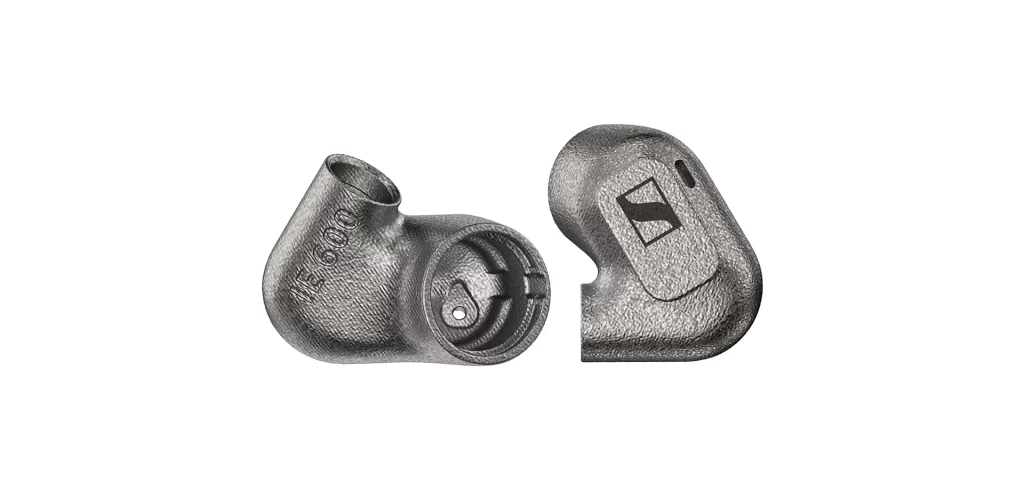
Here’s Sennheiser’s measurements and comparison to what it would sound like without the resonance chambers:
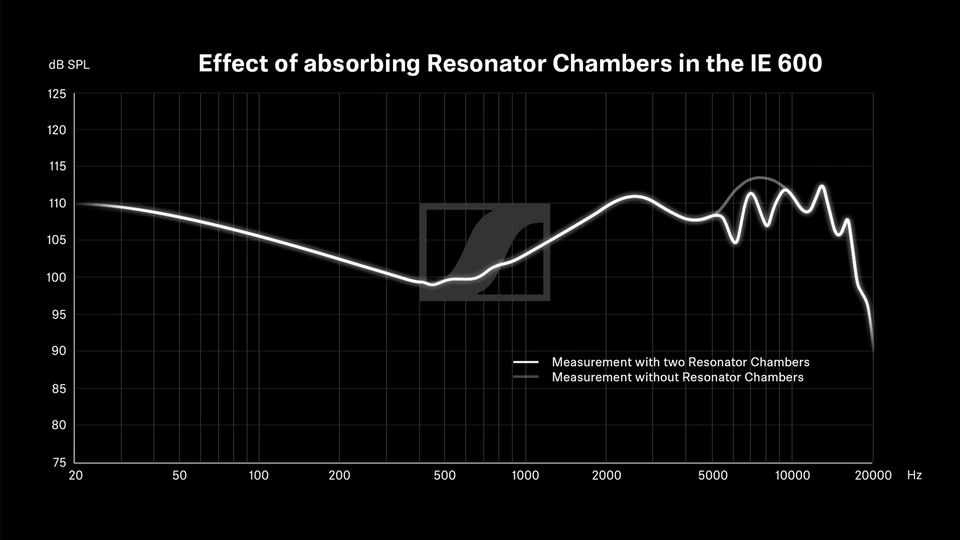
Most high-end IEMs are made using multiple drivers. Each driver then takes care of a specific part of the frequency spectrum, like a normal speaker with a crossover, tweeters and woofers. Sennheiser doesn’t go that route. They use a single driver on each side (obviously), more specifically a version of Sennheiser’s own TrueResponse transducer with a 7 mm diaphragm. The same 7 mm TrueResponse driver can be found in several of Sennheiser’s IEMs including the flagship IE900, as well as the IE200 and IE300.
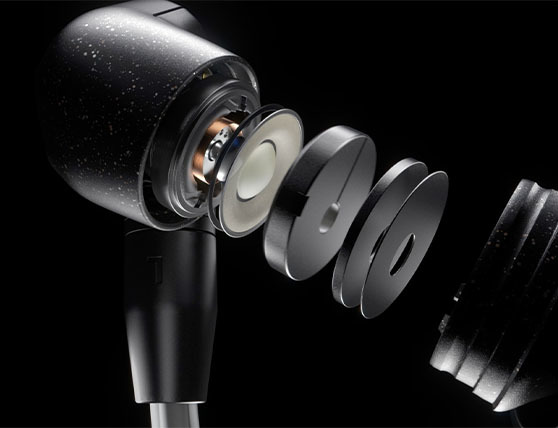
Multi-driver systems have advantages and disadvantages. They make it possible to optimize each driver for the frequency they shall reproduce but at the same time phase incoherence and distortion is a problem because of overlapping between drivers and because of the need for a crossover filter. With a single transducer, everything has to be reproduced by that single driver, which can be a challenge. However, almost every full size headphone in the world use a single driver so it should not be impossible with IEMs.
Sennheiser’s 7 mm TrueResponse transducer is quite impressive, and one of the world’s smallest of its kind. Sennheiser claims that distortion is extremely low too.
With regards to comfort, the IE600s are a joy to wear and are one of the few IEMs you can comfortably have in your ears while lying on the side resting your head on a pillow. The included tips are quite okay but I find them to require some effort to get a good seal and there is quite a size difference between the medium and large size. As always with IEMs, be prepared to buy your own tips if necessary. Every ear is different, and a good seal and comfortable tips are essential. One thing to note here is that the supplied tips has some mesh in front of the driver, which as far as I could tell makes the treble a bit softer.
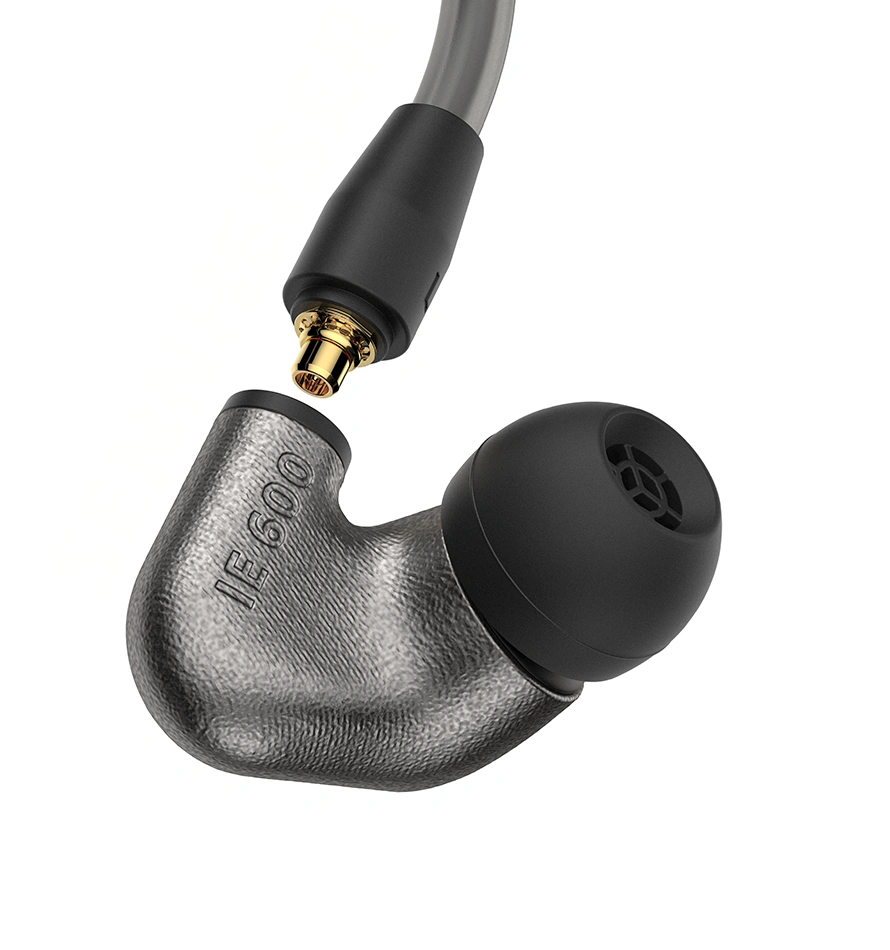
The included cable is made of a rubber-like material. I like that it has some friction. It is thin and lightweight. The MMCX cable connectors are protected with a circular flange that will be in the way if you use most 3rd party cables so be aware of this if you want to try other cables.
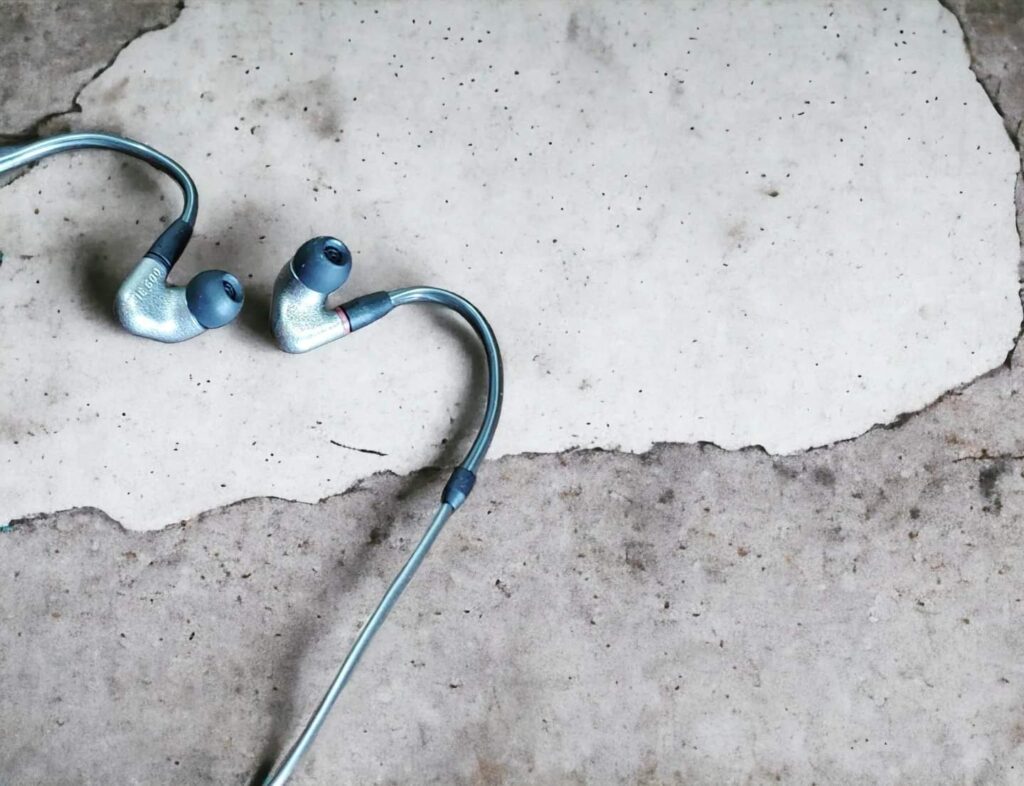
INITIAL LISTENING IMPRESSIONS
All listening impressions below are with the IE600 IEMs directly powered by the IEM output of the RME ADI-2 DAC FS using included ear-tips.
Rocket by Smashing Pumpkins
The bass is powerful and balances between tight and full in a delicious way. There’s certainly enough rumble. Percussion is tight and punchy, the vocals are just how they should be. Smashing Pumpkins have always fascinated me when they let the guitar and the bass play the same lines. It gives such a powerful sound. With the IE600, you can follow the guitar and bass separately but not in an analytical way. It’s a very full-bodied presentation.
Floratone by Floratone
The bass is quite powerful. The guitar has a warm glow to it. You can hear all the little details in the percussion, but it’s never too bright sounding. The soundstage is not extremely big, but it doesn’t feel closed in, just intimate.
Gilmanuk by Nils Petter Molvær
The bass is powerful, more than I am used to. It feels on the right side of too much, though. Molvær’s trumpet is beautifully rendered. If I EQ down the bass, it sounds perfect.
Khamsin by Jon Balke
The piano is crisp, delicate and natural sounding.
Intimate Letters – Martinu by Emerson String Quartet
This piece sounds very lively and engaging. The instrument separation is superb. You can follow every string on each instrument. There is a lot of texture and detail. The presentation is warm and inviting and never gets too bright or edgy.
Compare Manuel by Vicente Amigo
The presentation is very well-balanced. The bass is held in the background as it 8s supposed to be. The focus is on the fabulous guitar play, which is presented with crispness, speed and a warm tonality.
Muggen Fallskjerm by Jøkleba
The bass punches exactly like it should. The presentation is tight and dynamic. The soundstage isn’t huge, but instrument separation is great.
Army of Me by Björk
This sounds pretty much perfect with the IE600. You can easily hear how Björk’s vocals are double-tracked on the chorus.
Deepak Ine by John Talabot
Electronica. The bass is very satisfying. It’s deep, punchy and full-bodied without bleeding into the mids. I like how some sounds get this bouncy feeling that I have not heard like this before.
Never Forget The Good Ones by Solveig Slettahjell
Time for some slow female jazz vocals. The IE600 doesn’t disappoint. The vocals sound spot on. The trumpet too. The presentation is warm and inviting, detailed and quite spacious.
Almost Like the Blues by Leonard Cohen
The bass line is powerful and quite tight but with some bloom. Cohen’s voice is warm and with plenty of body, yet textured as only Cohen’s voice can be. The percussion is crisp but not too bright.
Sue by David Bowie
The bass is very powerful, maybe a little too much, depending on your preferences. However, it’s not flabby, there’s texture and a sense of tightness. Great separation. Bowie’s voice sounds natural and present.
Young Vivaldi, Violin Concerto in D minor by Ensemble Modo Antiquo
String music sounds very good on the IE600. Lots of texture and detail. No harshness or fatigue-inducing brightness. The instruments never sound thin or clinical.
The Eye of the Harry Cane by Tomasz Stanko
The walking bass is very nicely defined, balanced and easy to follow. The two trumpets are quite aggressive sounding, and the upper mids and treble have some real bite, without being too much. It just feels raw and energetic.
Ring by Glasser
There are details in the introduction that I never even noticed before. These are some extremely revealing in-ears. When the bass enters, it is with great presence and slight but pleasant bloom. Voices are nuanced and natural sounding.
It Could Be Sweet by Portishead
I don’t find the bass to be more powerful than it should be on this track. The vocals are given plenty of space and have great texture and nuances. You can hear Beth Gibbons’ every breath. The treble can sometimes feel close 5o being too bright/sibilant but just close. At least it’s not problematic for me.
The essence of my listening impressions with the ADI-2 DAC FS is that the IE600 has plenty of bass presence with good quality. The bass is sometimes a bit bloomy but never bloated. The mid-range is warm and inviting, yet full of detail and texture. The treble is never too bright, but it is crisp and clear. I am usually quite sensitive to bright headphones, but the IE600 doesn’t trigger fatigue for me.
The soundstage is neither big nor small, I’d call it slightly intimate. Instrument separation is top-notch without ever being clinical sounding.
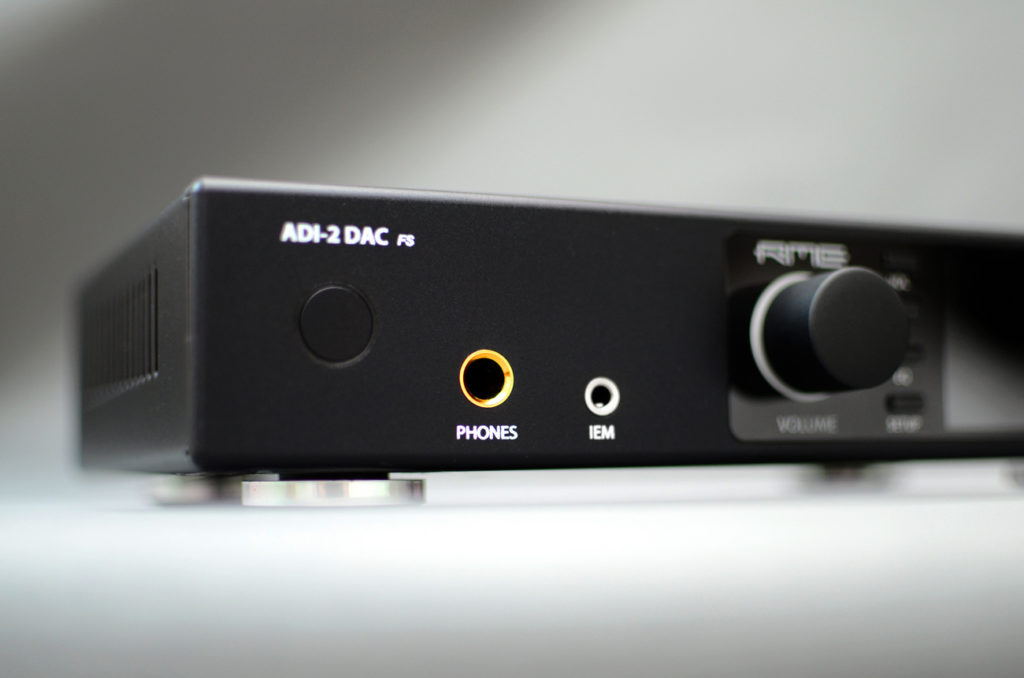
AMPLIFICATION
Having already established that the IE600 sounds very good with the RME ADI-2 DAC FS, I start trying out other options. Triggered by curiosity, I start with the least portable amplifier I have.
WOO WA22 TUBE AMP
It certainly feels a bit ridiculous plugging such small earphones into such a big amplifier but the sound is superb. There is no issue with hum, it’s as good as dead silent. The IE600 demands some power, and the WA22 delivers.
My Voice by Olga Konkova
The Cajón has great punch (but not too much) and is very textured. Vocals are delicate, rich and clear. The piano just sounds extremely nice.
Bergen Open by BMX
I love this playful jazz instrumental. The electric guitar has a nice glow to it. The percussion is punchy and delicate and the highs are liquid. The saxophone and trumpet sound alive.
Floratone by Floratone
The bass feels less pronounced, in a good way, than with the RME, the treble is also a bit more rounded.
I did not really know what to expect connecting the IE600 to the WA22 amplifier, but it was surprisingly spectacular. In some magical way, the WA22 made the IE600 perfect. The big tube amplifier manages to make the IE600 more rounded and more detailed at the same time. The sound stage becomes larger. The bass is less dominant, and the treble becomes more liquid.
DESKTOP AMPS
I sound all in one DAC/amp, the airway mentioned RME ADI-2 DAC FS is superb. With regards to dedicated desktop solid state amps I tried the following: The Monolith THX AAA 887 works excellently with the IE600, and I ended up using it for my IEM comparisons. It’s spacious, detailed and neutral. The Topping A90 sounded good. The Schiit Magni Heretic too. The Rebel Amp from Ukraine also sounds great. The Fiio K5 PRO was a good option (it also has a decent DAC), even if it was a bit less controlled than the other desktop amps it was better than all the dongles.
DONGLES
The Audioquest Red, Cobalt and THX Onyx all sound good, although the bass is tighter with the desktop amplifiers like the Monolith THX AAA 887. The Fiio K3 and xDuuo Bal2 sounded underpowered both with the unbalanced and balanced output.The bass was bloomy, loose and lacked precision, the soundstage was small and dense, instrument separation and detail suffered.
Concluding, the IE600 demands a significant amount of power and a quality DAC to sound its best.
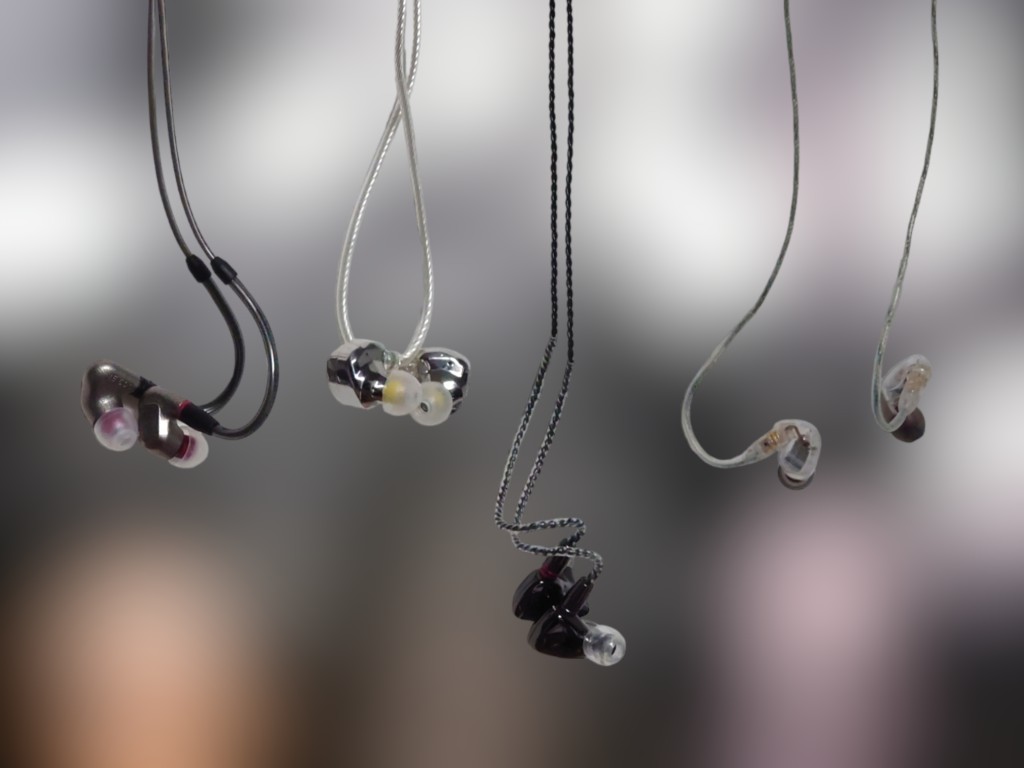
COMPARISONS
In the following I will compare the IE600 to a range of IEMs in various price classes. All comparisons were made using the Monolith THX AAA 887 amplifier and the RME ADI-2 DAC FS as a DAC.
SHURE SE215
This $99 headphone is less than a quarter of the IE600 price. Made for professional on-stage use, It is still a decent pair of IEMs for music listeners but not at the level of the IE600. When you get a good seal it has a very strong bass, which unlike the IE600 can get pretty bloated and muddy. Compared to the IE600 the SE215 feels thick and veiled with a small soundstage.
SHURE SE425
These $299 IEMs are, as the SE215, made for professional use. The SE425s are however a big step up from the 215. The SE425 is seductively smooth and detailed both in the mid-range and treble, with good separation and imaging. The IE600 is a bit rawer sounding and details are sharper and more pronounced at the cost of smoothness. The bass of the SE425 is less in quantity and of inferior quality compared to the IE800. I like both, and they certainly complement each other.
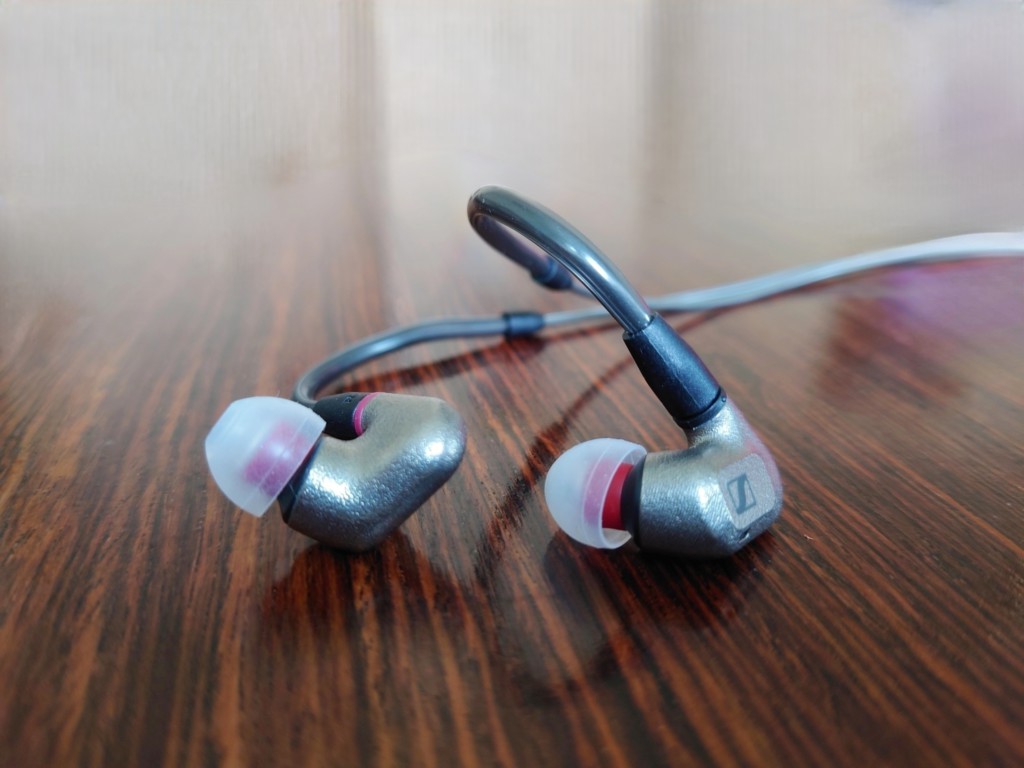
MOONDROP KATO VS IE600
The Kato has become an established reference IEM from the Chinese company Moondrop. It has a metal housing and a very nice cable. It cost appr. $190.
The Kato has an appealing presentation which is very spacious and light on its feet. The bass is not boosted and has good presence and quality.
With Portishead’s It Could Be Sweet the differences between the Kato and the IE600 are very apparent. The bass is much more present with the IE600, and the general presentation is fuller and darker. The vocals have more presence in the lower mids with the IE600 and in the upper mids with the Kato. The Kato sounds lighter and more airy, the IE600 fuller and with more body.
The electric guitar instrumental Lay It Down by Lee Ritenour sounds very good with both but there is more rumble and bloom in the bass with the IE600. It feels very tight and precise in the mid-range and treble, but the bass is a bit more coloured, for better and worse. If you prefer a full-sounding bass, then you’ll love the IE600. It’s not too much, just more than neutral. The Kato isn’t lacking in the bass, but it’s tighter. The general presentation is lighter, airier and crisper. The IE600’s sound is fuller and darker, in a very nice way.
I do not feel that the detail level is very far apart but the IE600 feels smoother and more liquid in the treble, whereas the Keto has more edge and bite.
In conclusion, the Kato and the IE600 have very different tuning. The Kato has crisper highs, less bass quantity and a more airy soundstage. The IE600 offers more bass, generally warmer sound, smoother treble and a more intimate sound-stage. Another difference worth mentioning is that the IE600 is significantly better in terms of comfort and size. For some, this will not matter but if you are on the go, the extremely lightweight, sturdy and compact construction can be worth the price difference by itself.
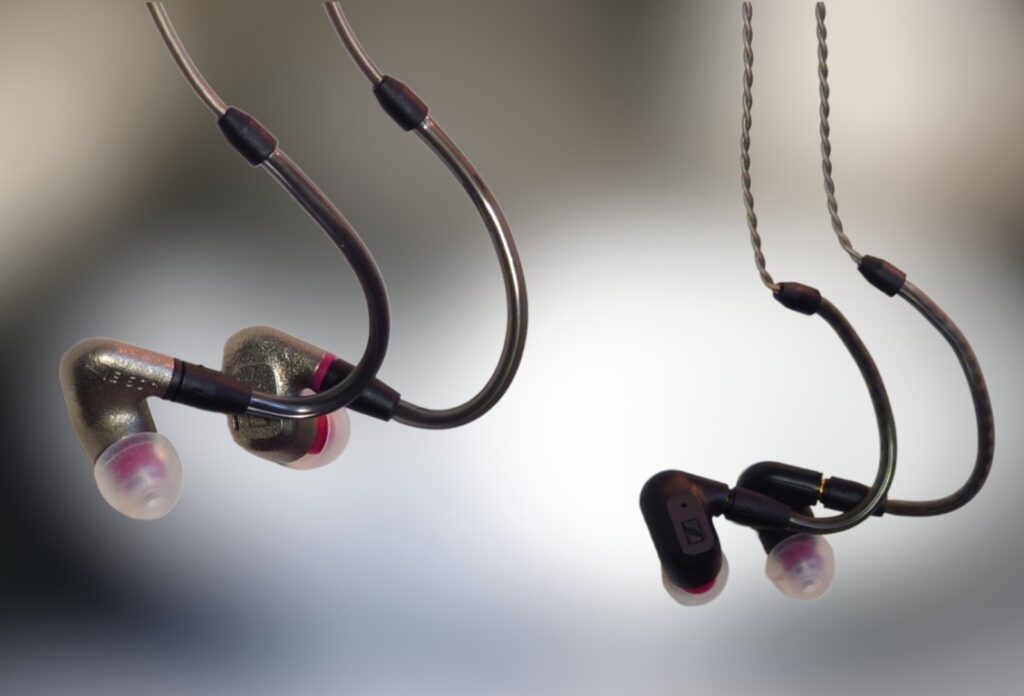
SENNHEISER IE200 VS IE600
These two are very similar in looks but are extremely different in price, approximately $150 vs. $600 (US). They are the same size and shape. The most apparent difference is that the bigger brother has metal housing. That’s not a small thing, because durability is increased a lot. The IE600 seems like something you can run over with your car. The metal and internal acoustics also affect the sound. IE200 is made in China, the IE600 in Germany.
Lay It Down by Lee Ritenour
Guitar-based blues instrumental. They are remarkably similar. The IE200 has a little less bass quantity and needs a bit more volume. I have to adjust it every time I change. More juice for the IE200. The IE600 feels a little bit crisper and clearer, but not much.
Limit to Your Love by James Blake
They are very similar here too. Again, the IE200 needs more volume.
Lounge Fly by Stone Temple Pilots
Again very similar. The IE200 feels just as clear as the IE600, maybe even a bit better at separation with this track.
Lyric Suite IV by A. Berg / Albin Berg Quartet
It isn’t easy to tell which one I prefer. They are similarly tuned, and they have similar detail levels. And, as always, need to adjust the volume level each time I switch. If I had to say anything I would maybe find IE600 a tad cleaner, but not much.
Almost Like the Blues by Leonard Cohen
The bass has a bit more body with the IE600, but it’s already strong enough for me with the IE200. Otherwise, differences are hard to distinguish.
As Before by Olga Konkova
There is a little bit more texture to the vocals with the IE600, and slightly more push in the lowest regions.
As I continue listening, the impressions remain unchanged. The IE600 is a bit more sensitive than the IE200, it has a bit more bass, and a bit more treble. Often it feels a bit more detailed, occasionally it is the other way around. But most of all these two headphones are incredibly similar. They both have plenty of bass, an intimate but good sound stage, detailed and warmish mid-range and nice treble resolution without too much energy.
The sound is very similar, after all they use the same driver and the sound differences are due to the different internal acoustics designs and materials of the housings alone. Soundwise, the plastic IE200 is a bargain; the price difference is not reflected in the sound difference. However, the IE600 is slightly better, and it’s built to outlive you.
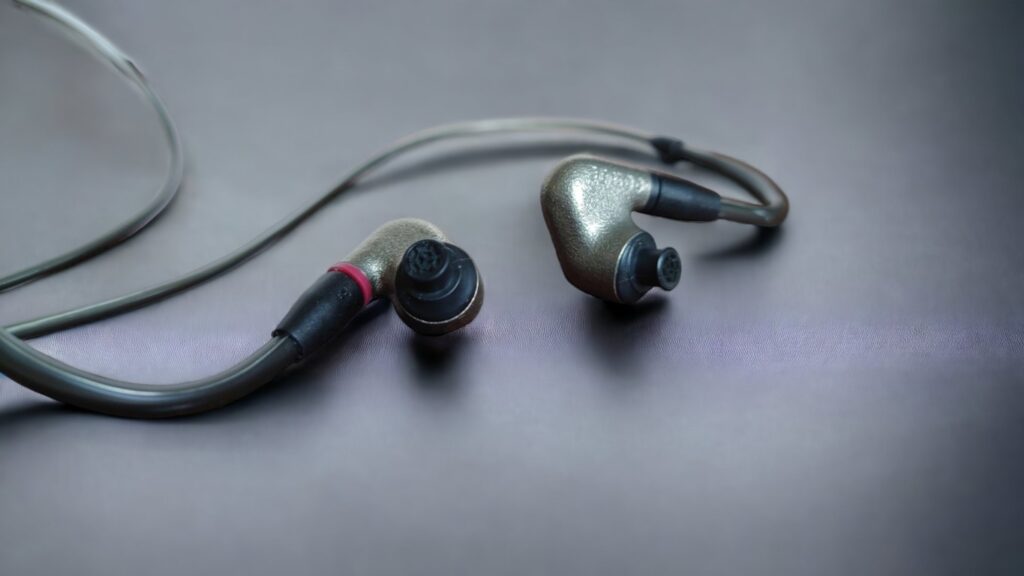
LETSHUOER S12 PRO VS IE600
The S12 has a single custom 14.8mm Planar Dynamic Driver, which is both larger and based on a different technology than the 7 mm dynamic TrueResponse driver of the IE600.
Soundwise, the S12 has a wider soundstage. The bass is quite good and punchy but quantity-wise it is less than the IE600. The S12 Pro also is generally brighter sounding, with a more energetic treble. It can feel a bit dry. The IE600 has significantly more refinement in the treble region, and except for the bigger soundstage, I prefer the IE600 overall. The S12 is great for the money, and they fit nicely in my ear when I find the right tips (for me it was Comply foams). They are very light and quite compact but not as small as the IE600.
iKKO OBSIDIAN OH10 VS IE600
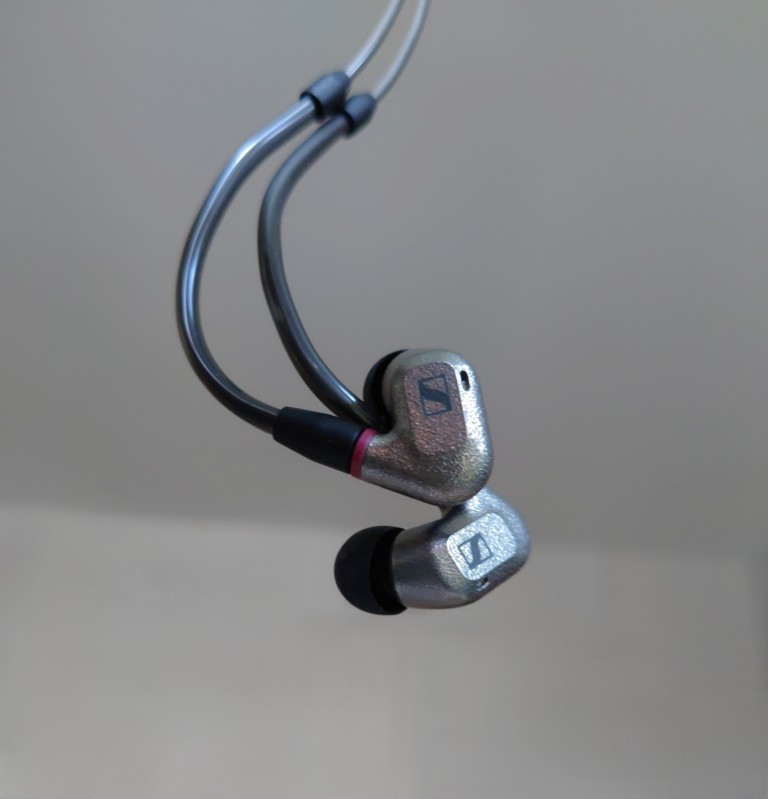
The iKKO OH10 is a very nice-sounding IEM. It is made of metal but unlike the IE600 it’s very heavy. It fits well in my ears, though.
The OH10 is a dual driver configuration, and the sound is very open and well-balanced. The bass is tight and powerful when asked for. The soundstage is open, the treble is crisp and clear. Separation between instruments is good.
Moving over to the IE600, the bass is fuller and has more bloom. The mid-range is less upfront, it sounds like it’s got less energy in the upper mids. The treble might be a bit more nuanced and liquid with the IE600.
The detail level overall is similar. The IE600 has more resolution in the treble, the OH10 has more texture in the bass.
The soundstage of the IE600 is smaller and a bit more focused, except for the bass. In many ways, I often prefer the iKKO, especially the tuning and the bass. The treble is a little bit splashy but the rest is all very nice.
In terms of comfort, the IE600s are way lighter, but more fiddly to insert into my ears.
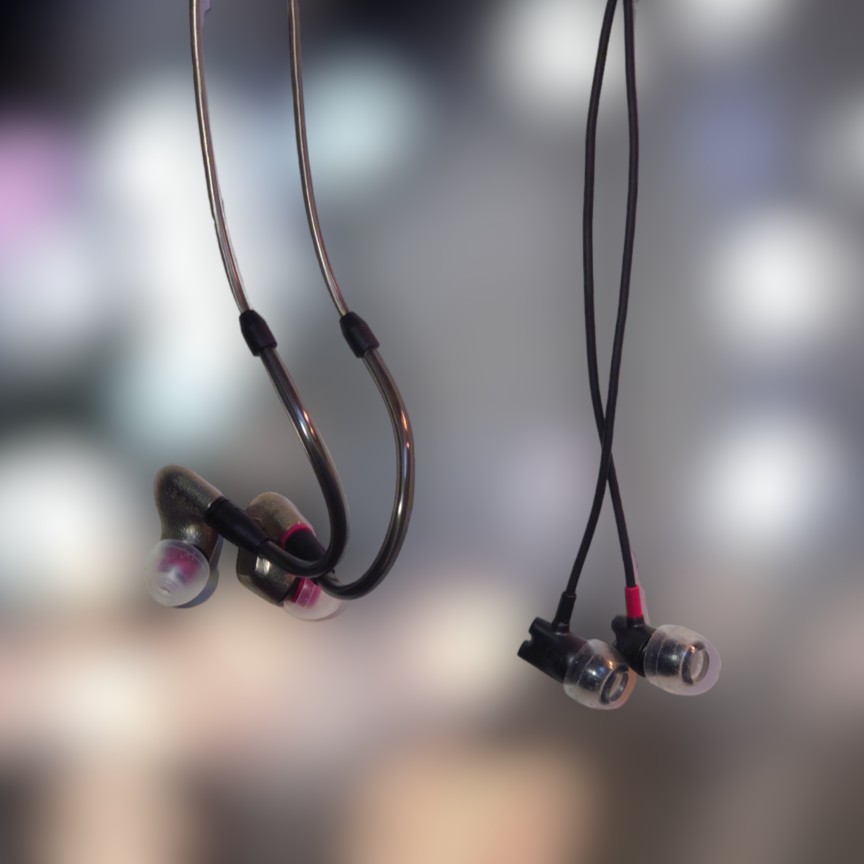
SENNHEISER IE800S VS IE600
The IE800S are by far the smallest hifi-speakers I’ve tried. As if the IE600 wasn’t small already, these are even smaller. The IE800Ss are made of a ceramic material and are miniscule. They are almost too small to be handled. The sound is amazing, though. That something smaller than half a dice can sound this amazing is impressive. It is no doubt whatsoever that this also is a Sennheiser: The IE600 and the IE800S are not tuned very differently. The two basically require the same amount of juice to reach the same listening level.
Heating Up by Fay Victor Ensemble
This is a beautiful jazz piece with female vocals. The IE600 offers a bit more spacious soundstage. The bass seems both a bit cleaner and fuller. The mid-range, however, is a clear win to the IE800S. It’s more present and offers more clarity and texture. Vocals are vivid and natural. The vocals on the IE600 are good but feel a bit dull in comparison. Also, the treble feels a little bit better defined with the IE800S.
Higdon’s Violin Concerto – 1726 by Hilary Hahn
Both sound very good with this fabulous performance. The IE600 is a bit more spacious and is also a little less bright. The IE800S gets a bit painful in the crescendos if you don’t watch the volume levels, the IE600 is just close to painful. However, if I just set the levels correctly, they’re both wonderful. The IE600 wins in spaciousness, the IE800S in giving me the extra small bit of fine nuance.
Identikit by Radiohead
Again, the room is bigger with the IE600, and the separation between instruments is better. The bass digs deeper and is more precise. When it comes to rendering Thom Yorke’s voice, however, the IE800S has it all the way. Not that the IE600 is bad in any way, it’s just that the IE800S makes it the vocals really come through, it’s more alive and natural with more texture and nuance.
All For Us by Labyrinth
The bass on the IE600 has much more texture than the IE800S. I guess size matters after all, even though they both are tiny in absolute terms. Here, the difference in soundstage isn’t really noteworthy. The IE800S still has the best vocals.
There Is No Right Time by Youandewan
With this instrumental electronica track, the IE800S sounds clearer and crisper. It doesn’t sound inferior in the bass or in terms of soundstage. It has a little more treble energy, but also more refinement. I prefer the IE800S here.
Bijou Voyou Caillou by Florian Pellissier Quintet
Here, the bass sounds much better with the IE600. It’s deeper and more defined. However, it sometimes gets a bit too dominant. The soundstage is also bigger. With the IE800S, the vocals take the main focus, the bass is less dominating and the soundstage is smaller with less space between the instruments.
To conclude, the IE600 and IE800S have different strong points. The IE600 has better soundstage and bass quality, the IE800S has a more present, organic mid-range and more liquid highs. A blend of the two would be ideal. It makes me curious about what the IE900 can offer.
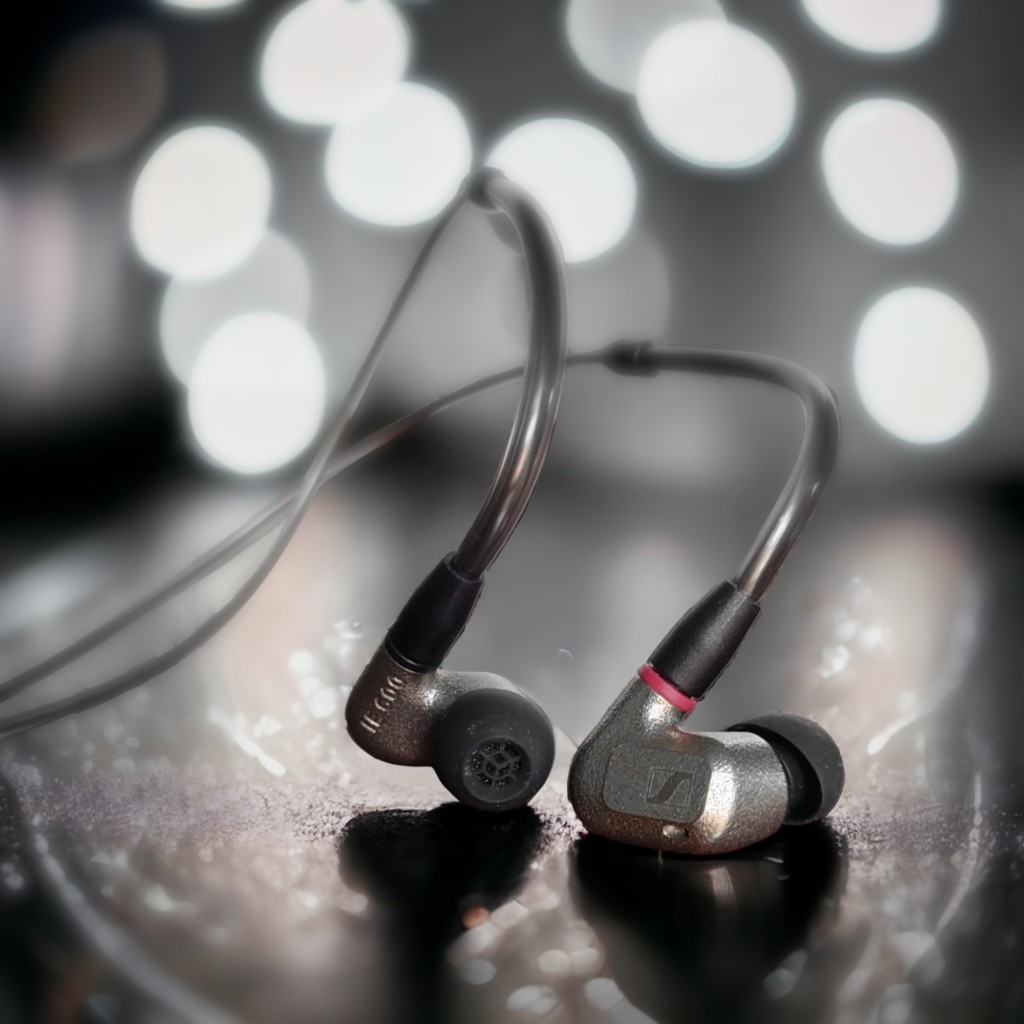
CONCLUSION
The IE600 is extremely small, comfortable and built to last a lifetime. It has strong but tight bass, crisp highs and mellow mids. It needs power to really shine, but once you get a proper source, it’ll give you lots of musical pleasure.
They are quite pricey and the little brother IE200 gives you a very similar sound experience. At this price point, the competition is steep. In the fast evolving world of IEMs, Sennheiser has fierce competition. Still, this might be one of the smallest, most comfortable and best sounding metal IEMs in production.
Buy on Amazon: Sennheiser IE600
Any purchase you make on Amazon or Linsoul with any of our affiliate links will give us a small provision at no cost to you.
We only get a provision for items that are not returned, so there’s no incentive for us to recommend something that’s not good.
Linsoul : Headphones, Earbuds, Wireless Earbuds, Desktop DAC/AMP, Portable DAC/AMP, Digital Audio Players,
Amazon: Headphones, IEMs, Headphone Amplifiers, Home Audio or Anything else.
.
If you enjoyed this article or other content on The Headphoneer, you might consider leaving a small donation to keep this website up and running. No donation is too small. Thanks for supporting us!
If you like our work please follow us on Instagram, Facebook and Twitter , it will help us grow. Sharing is caring 🙂
